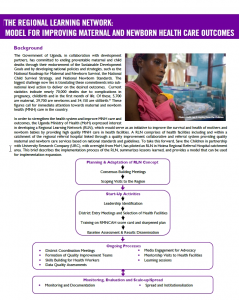
The Government of Uganda, in collaboration with development partners, has committed to ending preventable maternal and child deaths through their endorsement of the Sustainable Development Goals and by developing national policies and strategies, such as the National Roadmap for Maternal and Newborn Survival, the National Child Survival Strategy, and National Newborn Standards. The biggest challenge now lies is translating these commitments into sub-national level action to deliver on the desired outcomes. Current statistics indicate nearly 70,000 deaths due to complications in pregnancy, childbirth and in the first month of life. Of these, 5,700 are maternal, 29,700 are newborns and 34,150 are stillbirth.* These figures call for immediate attention towards maternal and newborn health (MNH) care in the country.
In order to strengthen the health system and improve MNH care and outcomes, the Uganda Ministry of Health (MoH) expressed interest in developing a Regional Learning Network (RLN), which would serve as an initiative to improve the survival and health of mothers and newborn babies by providing high quality MNH care in health facilities. A RLN comprises of health facilities including and within a catchment of the regional referral hospital linked through a quality improvement collaborative and referral system providing quality maternal and newborn care services based on national standards and guidelines. To take this forward, Save the Children in partnership with University Research Company (URC), with oversight from MoH, has piloted an RLN in Hoima Regional Referral Hospital catchment area. This brief describes the implementation process of the RLN, summarizes lessons learned, and provides a model that can be used for implementation expansion.